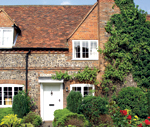Dos and don'ts of downsizing
Phil Spencer outlines some of the key considerations owners should take into account when thinking about going for a smaller property


The only way is up' goes the song and nowhere is this truer than on the property ladder. Buying bigger and better at every rung is the standard route most of us take, but there comes a time either in life or in market dynamics when some people decide enough is enough and a move in the other direction starts to look more appealing. Although it's true that the top end of the market today is driven by an entirely different set of factors and that in this price bracket, scarcity is a more prevailing factor than affordability, it's also true that interest-rate rises are affecting general sentiment and will surely take their toll on the more mortgage-led sectors. The problem is set to become a sharper one over the next year, when some two million homeowners who took out two-year fixed-rate deals will be forced into new mortgages at higher rates. I believe that the fundamental drivers of the market are still in reasonable health, but there is a limit to the level of debt people can actually service, and so, upward pressure on prices must be reduced as time goes by. Only very moderate growth can be expected over the next few years. These conditions, when combined with the fact that property tends to be our largest asset, means that some owner-occupiers are feeling that equity tied up in bricks and mortar is, in effect, 'dead money', which could better be invested, or enjoyed elsewhere. Prospective down-sizers will be considering their options in the months ahead. The decision is often taken by 'empty nesters', who find that living in too large a property has more negatives than positives. Releasing capital can fund either other ventures or, more and more, their children's property purchases. However, costs of maintenance, too many lawns to mow, beds to weed, and the desire for a more simplified and stress-free style of living are also common motivators in the decision to downsize. But exchanging your sprawling pile for something smaller doesn't have to equal rural exile or a repetition of The Good Life. Clever downsizing should be timed with the market conditions at the time. You need to do everything you can to maximise the original sale price in order to enable as many options in the future as possible. The two most important decisions you take will be instructing the right agent and setting the right price. If mistakes are made with either of these, the whole exercise risks futility. Increasing numbers of downsizers these days want to exchange the worry and expense of maintaining a large property, for the luxury of low maintenance and the opportunity for more leisure time. At Garrington, we are finding an increasing number of clients asking us to oversee the sale of their larger property as well as finding and securing a smaller home the phenomenon is definitely on the rise. It may be a relief to not need staff and heat a large house, but there are also a few key compromises the downsizer has to consider (see box). Emotional ties to what may have long been a family home are one of the main barriers to downsizing, but equally, deciding on where to move to, and what style of property will best suit, can be just as daunting a prospect. Downsizing has the potential to be both exciting and rewarding, but it involves important financial and emotional decisions clearly, it's a time of great change and mistakes are not easily rectified. Before taking the plunge, you need to be absolutely sure you've considered all the options and covered all the bases. THINGS TO CONSIDER BEFORE DOWNSIZING: Modern houses are easier to maintain and cheaper to heat Flats have communal areas over which you have no control Parking spaces reduce with the age and size of the property Period houses will need redecorating; modern ones often don't auctioneers to help
Exquisite houses, the beauty of Nature, and how to get the most from your life, straight to your inbox.
Country Life is unlike any other magazine: the only glossy weekly on the newsstand and the only magazine that has been guest-edited by His Majesty The King not once, but twice. It is a celebration of modern rural life and all its diverse joys and pleasures — that was first published in Queen Victoria's Diamond Jubilee year. Our eclectic mixture of witty and informative content — from the most up-to-date property news and commentary and a coveted glimpse inside some of the UK's best houses and gardens, to gardening, the arts and interior design, written by experts in their field — still cannot be found in print or online, anywhere else.
